Black Country: Difference between revisions
No edit summary |
No edit summary |
||
| Line 13: | Line 13: | ||
An older, definition uses geology and follows the outcroppings of the South Staffordshire coal seam known locally as the "Thirty Foot Seam", which is bounded by the eastern and western boundary faults and on the north by the Bentley fault, which divides the South Staffordshire coalfield from the adjoining Cannock Chase coalfield. Near [[Halesowen]] and [[Stourbridge]], the coal seams broke the surface, providing a southern boundary. This definition would exclude parts of Walsall, Wolverhampton and Stourbridge but include [[West Bromwich]], where the Thirty Foot Seam is at some depth beneath the surface. | An older, definition uses geology and follows the outcroppings of the South Staffordshire coal seam known locally as the "Thirty Foot Seam", which is bounded by the eastern and western boundary faults and on the north by the Bentley fault, which divides the South Staffordshire coalfield from the adjoining Cannock Chase coalfield. Near [[Halesowen]] and [[Stourbridge]], the coal seams broke the surface, providing a southern boundary. This definition would exclude parts of Walsall, Wolverhampton and Stourbridge but include [[West Bromwich]], where the Thirty Foot Seam is at some depth beneath the surface. | ||
A rule-of-thumb guide for outsiders suggests the M5 and M6 | A rule-of-thumb guide for outsiders suggests the [[M5 motorway|M5]] and [[M6 motorway]]s as the eastern boundary, a definition which falls down in its detail for excluding [[Smethwick]] east of the M5, and most of Walsall, north-east of the M6. | ||
==Towns== | ==Towns== | ||
| Line 34: | Line 34: | ||
*[[Kingswinford]] ''(Staffordshire)'' | *[[Kingswinford]] ''(Staffordshire)'' | ||
*[[Lye, Worcestershire|Lye]] ''(Worcestershire)'' | *[[Lye, Worcestershire|Lye]] ''(Worcestershire)'' | ||
*[[Netherton, | *[[Netherton, Black Country|Netherton]] ''(Worcestershire)'' | ||
*[[Oldbury, Worcestershire|Oldbury]] ''(Worcestershire)'' | *[[Oldbury, Worcestershire|Oldbury]] ''(Worcestershire)'' | ||
*[[Old Hill]] ''(Staffordshire)'' | *[[Old Hill]] ''(Staffordshire)'' | ||
| Line 76: | Line 76: | ||
By Victorian days, the Black Country was one of the most heavily industrialised areas in Britain, and it became known for its pollution, particularly from iron and coal industries and their many associated smaller businesses. This led to the expansion of local railways and coal mine lines. The Line running from Stourbridge to Walsall via Dudley Port and Wednesbury closed in the 1960s, but the Birmingham to Wolverhampton via Tipton is still a major transport route. | By Victorian days, the Black Country was one of the most heavily industrialised areas in Britain, and it became known for its pollution, particularly from iron and coal industries and their many associated smaller businesses. This led to the expansion of local railways and coal mine lines. The Line running from Stourbridge to Walsall via Dudley Port and Wednesbury closed in the 1960s, but the Birmingham to Wolverhampton via Tipton is still a major transport route. | ||
The anchors and chains for the ill-fated liner RMS ''Titanic'' were manufactured in the Black Country in the area of [[Netherton, | The anchors and chains for the ill-fated liner RMS ''Titanic'' were manufactured in the Black Country in the area of [[Netherton, Black Country|Netherton]]. Three anchors and accompanying chains were manufactured; and the set weighed in at 100 tons. The centre anchor alone weighed 12 tons and was pulled through Netherton on its journey to the ship by 20 shire horses. | ||
The area soon gained notoriety. Charles Dickens's novel ''The Old Curiosity Shop'', written in 1841, described how the area's local factory chimneys ''"Poured out their plague of smoke, obscured the light, and made foul the melancholy air".'' In 1862, Elihu Burritt, the American Consul to Birmingham, described the region as ''"black by day and red by night"'', because of the smoke and grime generated by the intense manufacturing activity and the glow from furnaces at night. | The area soon gained notoriety. Charles Dickens's novel ''The Old Curiosity Shop'', written in 1841, described how the area's local factory chimneys ''"Poured out their plague of smoke, obscured the light, and made foul the melancholy air".'' In 1862, Elihu Burritt, the American Consul to Birmingham, described the region as ''"black by day and red by night"'', because of the smoke and grime generated by the intense manufacturing activity and the glow from furnaces at night. | ||
Revision as of 11:59, 1 August 2017
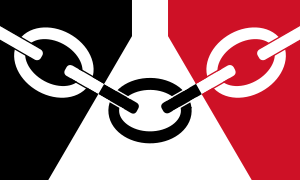
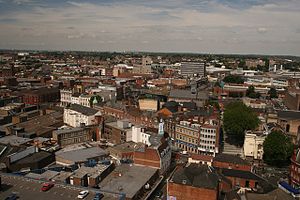
The Black Country is a loosely defined area of southern Staffordshire and northern Worcestershire which lies to the north and west of Birmingham, and to the south and east of Wolverhampton. The town of Dudley (Worcestershire) is sometimes referred to as being the Black Country's unofficial capital.[1]
The Black Country is divided between the counties of Stafford and Worcester, the greater part belonging to Staffordshire. Dudley is a detached part of Worcestershire surrounded by Staffordshire, separated from the main body of its own shire by a narrow strip.
By the late 19th century, the Black Country had become one of the most intensely industrialised in the nation. The South Staffordshire coal mines, the coal coking operations, and the iron foundries and steel mills that used the local coal to fire their furnaces, produced a level of air pollution that had few equals anywhere in the world at the time.
Extent
The bounds of the Black Country are not fixed nor agreed; some argue, for example, as to whether Wolverhampton is within the Black Country or on its northern edge. One common definition of the Black Country is to include the whole of the conurbation around its main towns, excluding those of Birmingham.
An older, definition uses geology and follows the outcroppings of the South Staffordshire coal seam known locally as the "Thirty Foot Seam", which is bounded by the eastern and western boundary faults and on the north by the Bentley fault, which divides the South Staffordshire coalfield from the adjoining Cannock Chase coalfield. Near Halesowen and Stourbridge, the coal seams broke the surface, providing a southern boundary. This definition would exclude parts of Walsall, Wolverhampton and Stourbridge but include West Bromwich, where the Thirty Foot Seam is at some depth beneath the surface.
A rule-of-thumb guide for outsiders suggests the M5 and M6 motorways as the eastern boundary, a definition which falls down in its detail for excluding Smethwick east of the M5, and most of Walsall, north-east of the M6.
Towns
The Black Country has coalesced into a single conurbation, but it has no single centre as some such conurbations do. It remains a group of historic market towns and swollen industrial villages which have coalesced during the 20th century. Many of the towns and villages remain recognisable, distinct communities, with their own local identities.
The Black Country's main towns are:
- Bilston (Staffordshire)
- Blackheath (Staffs / Worcs border)
- Brierley Hill (Staffordshire)
- Brownhills (Staffordshire)
- Coseley (Staffordshire)
- Cradley (Worcestershire)
- Cradley Heath (Staffordshire)
- Darlaston (Staffordshire)
- Dudley (Worcestershire)
- Gornal (Staffordshire)
- Great Bridge (Staffordshire)
- Halesowen (Worcestershire)
- Kingswinford (Staffordshire)
- Lye (Worcestershire)
- Netherton (Worcestershire)
- Oldbury (Worcestershire)
- Old Hill (Staffordshire)
- Quarry Bank (Staffordshire)
- Rowley Regis (Staffordshire)
- Sedgley (Staffordshire)
- Smethwick (Staffordshire)
- Stourbridge (Worcestershire)
- Tipton (Staffordshire)
- Walsall (Staffordshire)
- Wednesbury (Staffordshire)
- Wednesfield (Staffordshire)
- West Bromwich (Staffordshire)
- Willenhall (Staffordshire)
- Wordsley (Staffordshire)
The name of "The Black Country"

The Black Country is relatively recent as a concept and identity, coming out of the development of south Staffordshire in the industrial revolution, the expression "Black Country" first arising, it seems, in the 1840s.[2] It is popularly believed that the area got its name because of pollution from these heavy industries that covered the area in black soot. However, some historians suggest that the name might have existed even before the Industrial Revolution, taken from the outcroppings of black coal which scarred the surface of the local heath, and the local soil rendered very black by the presence of coal so near the surface.
The Black Country today
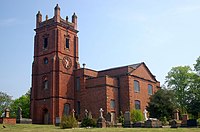
The heavy industry which once dominated the Black Country has now largely gone. The 20th century saw a decline in coalmining and the industry finally came to an end in 1968 with the closure of Baggeridge coalpit near Sedgley. Clean air legislation has meant that the Black Country is no longer black. The area still maintains some manufacturing, but on a much smaller scale than historically.
Much of the area now suffers from high unemployment and parts of it are amongst the most economically deprived communities in the United Kingdom. This is particularly true in parts of the boroughs and towns around West Bromwich, Walsall and Wolverhampton.<IMD2007> According to the Government's 2007 Index of Deprivation (ID 2007), the West Bromwich area is the third most deprived authority in the West Midlands region, coming after Birmingham and Stoke-on-Trent, and "Sandwell" the 14th most deprived of Britain's 354 local government districts. Dudley fares better, but still has pockets of deprivation, an affluent town centre contrasting with its outer suburbs.
The Black Country suffered its biggest economic blows in the late 1970s and early 1980s, when unemployment soared largely because historic large factories closed, including the Round Oak Steel Works at Brierley Hill and the Patent Shaft steel plant at Wednesbury. Unemployment rose drastically across the country during this period as part of the modernisation process of Britain's industrial structure. These areas were designated as Enterprise Zones and within a few years had been redeveloped. Round Oak and the surrounding farmland was developed as the Merry Hill Shopping Centre and Waterfront commercial and leisure complex, while the Patent Shaft site was developed as an industrial estate.
The Black Country Living Museum in Dudley recreates life in the Black Country in the early 20th century, and is a popular tourist attraction.
History
Industrialisation in the Black Country goes far back. It was already an area where metal working was important as far back as the 16th century, due to the presence of iron ore and of coal in a seam 30 feet thick, the thickest seam in Great Britain, which outcropped in various places. Many people had an agricultural smallholding and supplemented their income by working as nailers or smiths, an example of a phenomenon known to economic historians as proto-industrialisation.
In the English Civil War, the Black Country provided the arms with which King Charles could defend his throne. In 1642 at the start of the war, Charles I failed to capture the two arsenals of Portsmouth and Hull, cities adhering to Parliament though in counties loyal to the King. Having failed to capture the arsenals, Charles had no supply of swords, pikes, guns, or shot; all these the Black Country could and did provide. From Stourbridge came shot, from Dudley cannon. The numberless small forges which then existed on every brook in the north of Worcestershire turned out successive supplies of sword blades and pike heads. It was said that among the many causes of anger Charles had against Birmingham was that one of the best sword makers of the day, a man named Robert Porter, who lived and made his blades in Worcestershire, but sold them in Birmingham, refused at any price to supply swords for "that man of blood" (A Puritan nickname for King Charles), or any of his adherents. As an offset to this sword maker, the Royalists had among their adherents Colonel Dud Dudley, who had invented a means of smelting iron by the use of coke, and who claimed he could turn out "all sorts of bar iron fit for making of muskets, carbines, and iron for great bolts", both more cheaply, more speedily and more excellent than could be done in any other way. His method was employed on the King's behalf.[3][4]
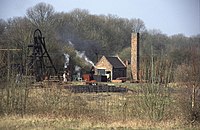
By the 19th century or early 20th century, many villages had their characteristic manufacture, but earlier occupations were less concentrated. Some of these concentrations are less ancient than sometimes supposed. For example, chain making in Cradley Heath seems only to have begun in about the 1820s, and the Lye holloware industry is even more recent.
Before the Industrial Revolution, coal and limestone were worked only on a modest scale for local consumption, but during the Industrial Revolution by the opening of canals, such as the Birmingham Canal Navigations, Stourbridge Canal and the Dudley Canal (the Dudley Canal Line No 1 and the Dudley Tunnel) opened up the mineral wealth of the area to exploitation. Advances in the use of coke for the production in iron enabled iron production (hitherto limited by the supply of charcoal) to expand rapidly.
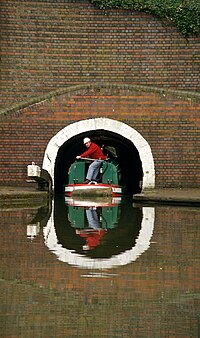
By Victorian days, the Black Country was one of the most heavily industrialised areas in Britain, and it became known for its pollution, particularly from iron and coal industries and their many associated smaller businesses. This led to the expansion of local railways and coal mine lines. The Line running from Stourbridge to Walsall via Dudley Port and Wednesbury closed in the 1960s, but the Birmingham to Wolverhampton via Tipton is still a major transport route.
The anchors and chains for the ill-fated liner RMS Titanic were manufactured in the Black Country in the area of Netherton. Three anchors and accompanying chains were manufactured; and the set weighed in at 100 tons. The centre anchor alone weighed 12 tons and was pulled through Netherton on its journey to the ship by 20 shire horses.
The area soon gained notoriety. Charles Dickens's novel The Old Curiosity Shop, written in 1841, described how the area's local factory chimneys "Poured out their plague of smoke, obscured the light, and made foul the melancholy air". In 1862, Elihu Burritt, the American Consul to Birmingham, described the region as "black by day and red by night", because of the smoke and grime generated by the intense manufacturing activity and the glow from furnaces at night.
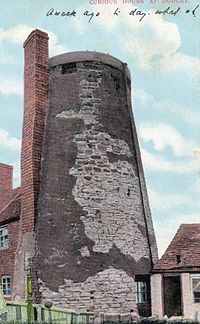
It is said that J R R Tolkien based the grim region of Mordor on the heavily industrialised Black Country area in his famed novel The Lord of the Rings. Indeed, in the Elvish "Sindarin" language, Mor-Dor means Dark (or Black) Land, and is sometimes even referred to within the novel as "The Black Country".
People
The Black Country is known for its distinctive dialect, which differs slightly in various parts of the region.
Despite its proximity to Birmingham, the vast majority of the Black Country's population refuse to be associate with that city, and are fiercely proud of their area's identity as a separate region.
As with many urban areas in the United Kingdom, there is also a significant ethnic minority population in parts: in "Sandwell" (West Bromwich, Smethwick etc), 22.6% of the population is from ethnic minorities, and in Wolverhampton the figure is 23.5%. However, in Walsall 84.6% of the population is described as white, and in Dudley 92%. Resistance to mass immigration in the 1950s, 1960s and 1970s led to the slogan "Keep the Black Country white!".
The Black Country now has its own tartan, designed by Philip Tibbetts from Halesowen.[5][6] The Black Country Tartan black, red, white and yellow, denoting coal, red sunsets, the iron industry and Mercia's flag. Mr Tibbetts said the red was representative of an old saying which went, "the Black Country is black by day and red by night". In 2008 he designed a Black Country coat of arms and flag.
Black Country dialect
The traditional Black Country dialect preserves many archaic traits of Early Modern English and even Middle English,[7] and can be very confusing for outsiders. Thee, Thy and Thou are still in use, as in parts of Yorkshire and Lancashire. "'Ow B'ist", meaning "How are you?" is a common greeting, with the typical answering being "'Bay too bah", meaning "I am not too bad". "I haven't seen her" becomes "I ay sid 'er". Black Country dialect often uses "ar" where other parts of England use "yes" (this is common as far away as Yorkshire. Similarly, the local version of "you" is (jau) "yow", rhyming with "now". The local pronunciation "goo" (elsewhere "go") or "gooin'" is similar to that elsewhere in the Midlands. It is quite common for broad Black Country speakers to say agooin where others say going. (However many phrases and usages are local to individual towns, Dudley and its neighbourhood being particularly distinct.)
Inhabitants are proud to be known as Black Country folk and resist hints at any relationship to people living in Birmingham, calling Birmingham "Brum-a-jum" (Birmingham's colloquial name is Brummagem) or "Birminam", as it is pronounced locally. Men of Birmingham (Brummies) meanwhile often refer to their Black Country neighbours as "Yam Yams", a reference to the use of "Yow am" ( or yow'm) instead of "You are". Dudley residents often refer to the people of Birmingham as 'Dummy Brummies'. Also, the town of Walsall can be pronounced either War-sall or Wor-sull, with a strong Walsall accent considered to be typical "yam-yam."
The strong Black Country dialect is less commonly heard today than in the past. However, a stronger variation of the dialect (than the one frequently used) appears to be heard quite often in conversations between older Black Country folk. It has been boosted recently though thanks to an internet video describing the whole alphabet in Black Country Speak. The Black Country Alphabet
A road sign containing local dialect was placed at the A461/A459/A4037 junction in 1997 before the construction of a traffic island on the site. The sign read:
- "If yowm saft enuff ter cum dahn 'ere agooin wum, yowr tay ull be spile't."
- which in translation, "If you're stupid enough to come down here on your way home, your supper will be spoilt."[8][9] This island was completed in 1998 and was the first phase of the Dudley Southern By-Pass which was opened on 15 October 1999.
The word endings with 'en' are still noticeable in conversation as in gooen for going, callen for calling. The vowel a is pronounced as o as in sond for sand, hond for hand, opple for apple, sponner for spanner, and mon for man.[10] Local dialect was (and probably still is to a lesser degree) quite distinctive between the different towns and villages of the Black Country. Although most outsiders to the Black Country cannot tell this difference, Black Country folk can quite fiercely defend the difference between the accents.
A few examples of Black Country words are "babby" for baby, "alf baerked" for stupid, "argy-bargy" for fight and "bostin" to mean "very good".
A single example of Black Country dialect is hard to give, as different areas of the Black Country differ with colloquialisms. Dudley is often referred to as the "heart" of the Black Country, with the broadest accent of the Black Country coming from there and surrounding areas. Northern neighbour Wolverhampton and nearby, fellow Black Country town Walsall both differ from each other in broadness and dialect as well as from Dudley, though Walsall accents tend to retain more elements of the Dudley dialect than Wolverhampton ones.
References
- ↑ "What and where is the Black Country?". BBC.co.uk. http://www.bbc.co.uk/blackcountry/uncovered/what_is.shtml. Retrieved 2010-07-27.
- ↑ Jones, Peter M. (2009). "Birmingham and the West Midlands". Industrial Enlightenment: Science, technology and culture in Birmingham and the West Midlands, 1760-1820. Manchester: Manchester University Press. p. 22. ISBN 0719077702. "The notion of the Black Country, that is to say, a crude rectangle of territory bounded by Wolverhampton and Walsall to the north and Smethwick, Halesowen and Stourbridge to the south, is also an anachronism, since the expression cannot be traced back beyond the 1840s"
- ↑ John William Willis-Bund. The Civil War In Worcestershire, 1642-1646: And the Scotch Invasion Of 1615, Birmingham: The Midland Educational Company, ltd., 1905, pp. 4,5,88
- ↑ Joan Zuckerman, Geoffrey Eley. The Birmingham heritage, Taylor & Francis, 1979. ISBN 0-85664-875-2, 9780856648755. p. 34
- ↑ Black Country gets its own tartan BBC NEWS, January 12, 2009
- ↑ Reference: WR3278 Scottish Tartan World Register
- ↑ Staff and Agencies Wolverhampton researches Black Country dialect Guardian Unlimited, January 27, 2003
- ↑ Scotland (2003-01-27). "The Black Country". Submitresponse.co.uk. http://www.submitresponse.co.uk/archives/the_black_country.php. Retrieved 2009-06-02.
- ↑ "A collection of weird news stories from around the world". Meldrum.co.uk. http://www.meldrum.co.uk/mhp/charivari_9705.html. Retrieved 2009-06-02.
- ↑ "Black Country Dialect". http://www.sedgleymanor.com/dictionaries/dialect.html. Retrieved 2008-08-05.
Further reading
- Raybould, T.J. (1973). The Economic Emergence of the Black Country: A Study of the Dudley Estate. Newton Abbot: David & Charles. ISBN 0-7153-5995-9.
- Rowlands, M. B. (1975). Masters and Men in the West Midlands metalware trades before the industrial revolution. Manchester: Manchester University Press.
- Gale, W. K. V. (1966). The Black Country Iron Industry: a technical history London: The Iron and Steel Institute.
- Higgs, L. (2004) A Description of Grammatical Features and Their Variation in the Black Country Dialect Schwabe Verlag Basel.
Outside links
- Black Country Dialect
- Black Country Urban Park plans
- The Black Country 1911 Encyclopædia Britannica article
- BBC Black Country BBC website for Dudley, Sandwell, Walsall and Wolverhampton
- Black Country Connections - a project aimed at building a Genealogical tree of Black Country people